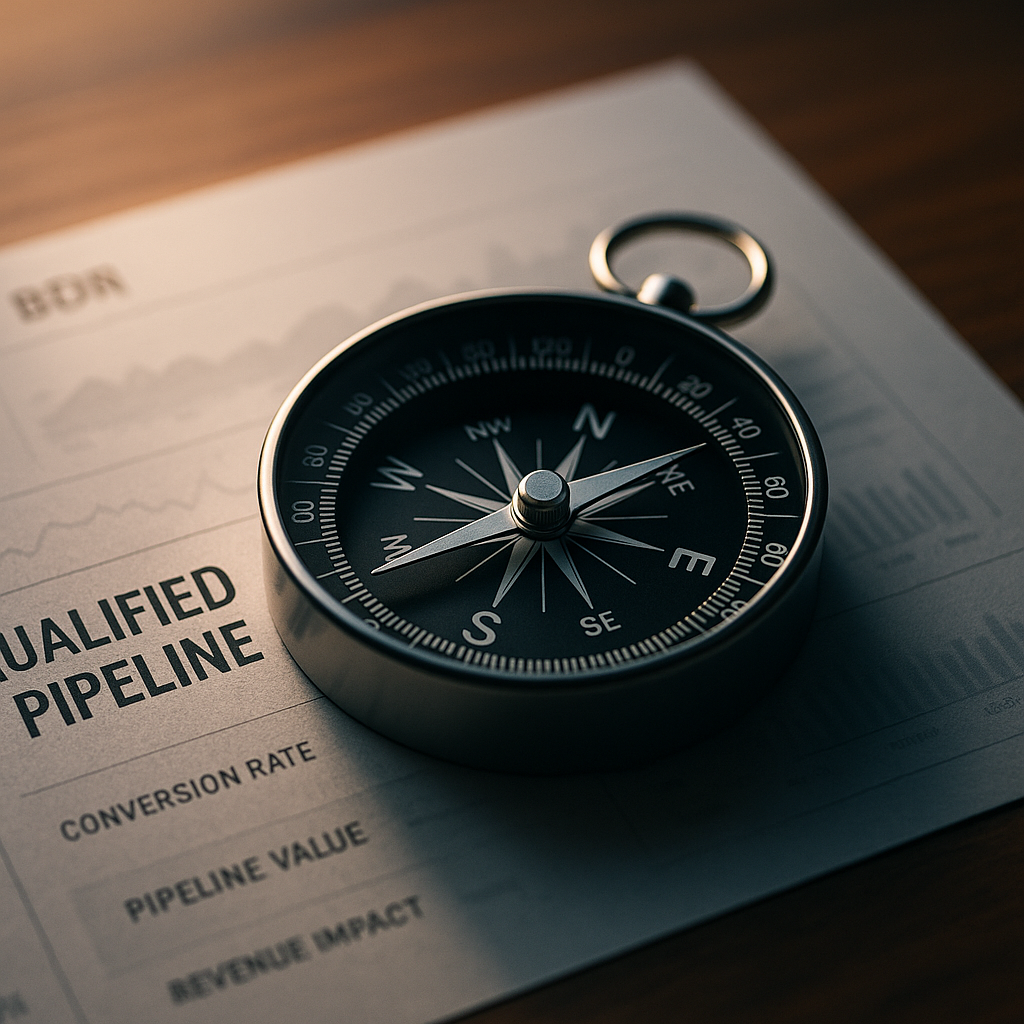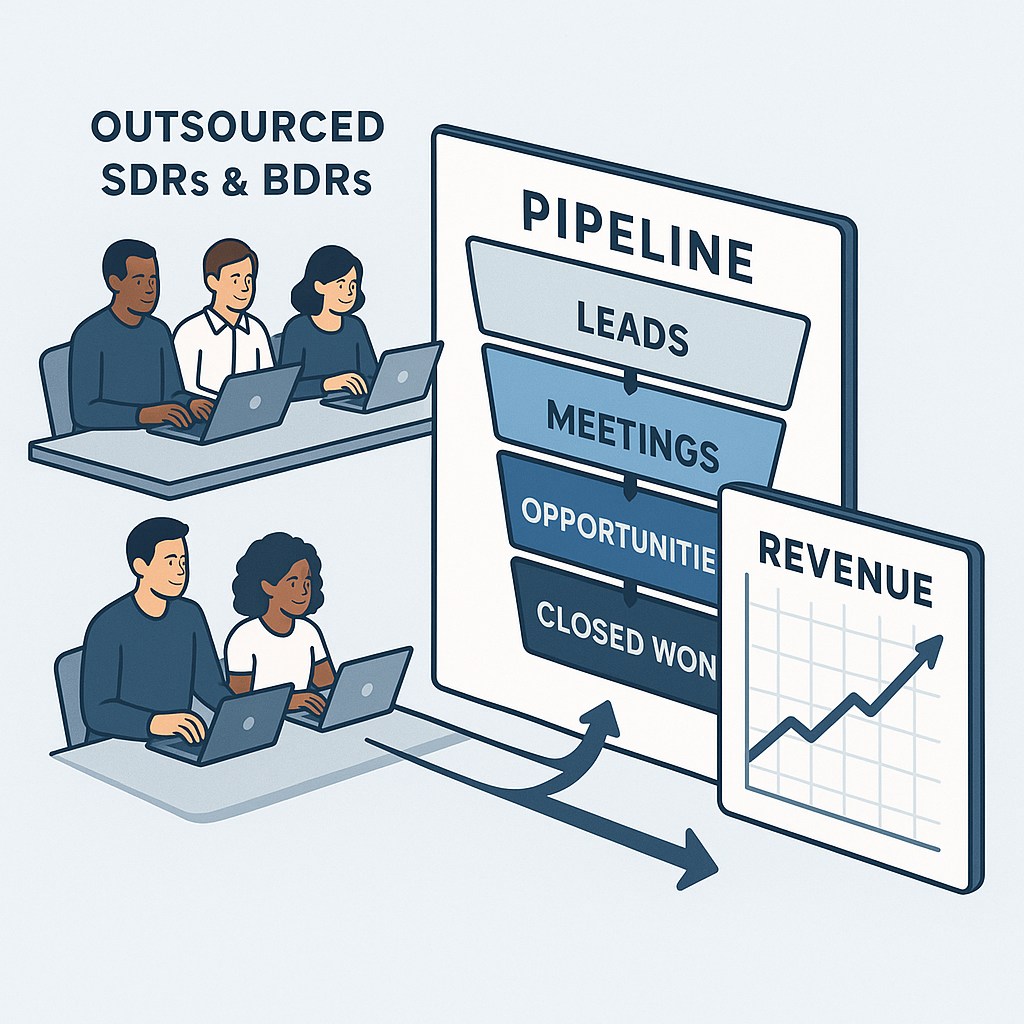BDR Success Metrics: KPIs You Should Track for Your Outsourced BDR Program
Is your BDR team generating qualified sales leads, or just logging activity? For RevOps leaders, that distinction is everything. When metrics focus...
%20(23).png?width=302&height=302&name=_SD%20web%20assets%202025%20(500%20x%20500%20px)%20(23).png)
7 min read
Eric Smith
:
Sep 30, 2025 2:00:00 PM
If your BDRs treat every inbound lead the same, you're not just wasting time. You're wasting pipeline. The real question for Demand Gen Directors: Are your leads being qualified fast and deep enough to convert?
According to Salesforce, only 13% of B2B leads turn into opportunities, and the average lead-to-opportunity time is a painful 84 days. That’s nearly three months of missed revenue potential. Lead qualification isn’t a handoff issue. It’s a strategy one. When it breaks down, campaigns underperform, AEs chase bad fits, and pipeline velocity stalls.
This guide breaks down how SmithDigital’s BDR teams qualify inbound leads with precision. Inside are the frameworks, data tools, and alignment moves that turn interest into impact faster.
A strong BDR lead qualification process filters noise and focuses on conversion-ready leads. It helps sales teams prioritize effectively and prevents wasted cycles on bad-fit prospects.
BDRs sit at the top of the funnel, reviewing inbound interest and executing outbound outreach. Their job is to assess buyer intent signals and apply consistent qualification criteria. Without that rigor, pipelines get bloated, AEs chase the wrong leads, and revenue stalls.
Qualification done right delivers faster handoffs, tighter feedback loops, and healthier forecasts. It gives you a clear, actionable B2B lead qualification strategy.
Frameworks reduce guesswork and bring consistency to how reps evaluate prospects. The right model depends on deal complexity and sales motion.
BANT is best for transactional deals. It qualifies based on Budget, Authority, Need, and Timeline. But in modern buying journeys, budget and authority often aren’t confirmed early. Use BANT flexibly, especially in early-stage discovery. HubSpot’s guide on BANT covers practical use cases.
MEDDIC is ideal for complex B2B sales. It emphasizes Metrics, Economic Buyer, Decision Criteria, Process, Pain, and Champions. Reps can apply a lighter version to uncover pain early and identify internal advocates.
CHAMP starts with the buyer’s challenges, not your solution. GPCTBA/C&I aligns sales conversations with strategic goals, plans, and implications. Both frameworks push reps to focus on buyer context, not checklists.
Today’s BDRs qualify leads by interpreting behavior such as email engagement, page visits, and other buying signals, not just by asking questions. Scoring models help rank leads based on fit and readiness to convert.
At SmithDigital, buyer intent data guides outreach timing and messaging. CRM automations surface qualified leads in real time, while routing logic ensures the right rep follows up quickly. Dashboards offer visibility into disqualified leads, handoff speed, and aging, allowing managers to catch breakdowns before they affect revenue.
This data-first approach ensures BDRs spend more time on the leads that actually matter. Many companies scale this capability with outsourced BDR teams that specialize in qualification.
Qualification falls apart when sales and marketing aren't aligned. A shared lead scoring model is essential for balancing behavior (site activity, email clicks), demographics (role, seniority), and firmographics (company size, industry).
But scoring is only effective if both teams agree on thresholds and triggers. Misaligned expectations result in MQLs that stall or get rejected. Regular review sessions, weekly or biweekly, help teams spot issues in real time and refine criteria. Shared dashboards in the CRM ensure transparency and accountability across functions.
When sales and marketing align on what “qualified” means, handoffs improve, and conversion rates rise.
Even with strong frameworks in place, execution often breaks down. These challenges quietly erode pipeline quality and sales trust if left unaddressed.
An ICP isn’t just a job title. It’s a blueprint for product fit: pain points, tech stack, buying triggers, and business context. When ICPs are vague or outdated, reps waste time on accounts that never convert.
Fix: Reevaluate ICPs quarterly using win/loss insights, firmographic data, and AE feedback.
Some BDRs disqualify too aggressively based on rigid frameworks. Others qualify everything just to hit volume goals. Both behaviors clog the pipeline and burn AE trust.
Fix: Fix: Treat qualification as a spectrum. Use call reviews to coach judgment and calibrate based on outcomes, not assumptions. Teams facing persistent misfires often explore outsourcing their SDR/BDR function to regain consistency.
Inbound leads often come in with limited data—no firmographics, no engagement history. Blind outreach based on thin records leads to weak replies.
Fix: Equip reps with a checklist and research tools (LinkedIn, company sites, enrichment software) to fill in key gaps before outreach.
Even with a defined lead scoring system, reps may ignore or misinterpret scores—especially under pressure to book meetings. This leads to misaligned handoffs and wasted AE follow-up.
Fix: Train BDRs to trust the score but validate with discovery. Highlight examples in pipeline reviews where scoring aligned—or failed.
When AEs don’t give feedback on passed leads, BDRs are left guessing what qualifies. Over time, this leads to misalignment and deteriorating lead quality.
Fix: Create a structured feedback loop post-handoff. Short AE notes (even in CRM fields) help BDRs fine-tune qualification instincts.
Top-performing BDR teams don’t rely on scripts or luck. They follow structured systems that blend research, timing, and collaboration to qualify smarter. These best practices drive consistency, reduce pipeline clutter, and improve win rates.
Buyers can spot generic messaging instantly. BDRs should tailor their outreach based on specific signals like job title, recent company announcements, or technology stack. Mentioning a recent funding round or product launch shows relevance and earns attention. SmithDigital’s BDRs use this intelligence to craft more targeted messages that resonate from the first touchpoint.
One channel is not enough. BDRs should engage leads across email, phone, LinkedIn, and SMS to identify the channel where the prospect is most responsive. Multichannel sequences improve visibility and give reps more opportunities to qualify intent early in the cycle.
Strategic accounts require more than a general pitch. Playbooks should include account-specific talking points, mapped personas, value propositions, and common objections. These assets help BDRs ramp faster and deliver more confident, consistent outreach, especially when pursuing decision-makers across multiple departments.
SmithDigital’s outsourced BDR teams use account-specific playbooks built from market insights, past conversion data, and persona-level research, enabling reps to ramp quickly and convert high-priority leads with confidence.
AI tools can analyze engagement data, detect buying signals, and update lead scores in real time. This helps reps prioritize prospects who are actively showing interest, while automation handles lead nurturing for colder contacts. When AI augments the qualification process, BDRs spend less time guessing and more time selling.
Reps shouldn’t start with a blank slate. Standardized checklists, like covering firmographics, digital footprint, tech stack, and ICP alignment, ensure every outbound message is contextually relevant. Even two minutes of prep can make the difference between getting ignored and getting a meeting booked.
Inconsistent messaging confuses prospects and weakens credibility. BDRs should mirror the language used in campaigns, nurture tracks, and AE sales pitches. Shared positioning across touchpoints improves brand recognition and reinforces the value proposition throughout the buyer journey.
Qualification is not a one-and-done checklist. The best teams meet regularly to review pipeline trends, analyze recent handoffs, and coach on evolving qualification standards. This keeps everyone aligned, sharpens rep instincts, and reduces friction between BDRs and AEs.
At SmithDigital, these practices aren’t optional. They’re operationalized into every rep’s workflow. From research protocols to AI-driven scoring and structured coaching, our outsourced BDR teams are built to qualify with precision. The result is fewer dead ends, faster handoffs, and more meetings that actually convert. For organizations looking to scale their pipeline without compromising quality, it’s a system that delivers measurable results.
Strong qualification processes don’t just “feel” efficient. They show up in the numbers. The right metrics reveal whether your BDR team is passing sales-ready leads or clogging the pipeline with low-fit contacts. These four KPIs offer critical insight into the health of your qualification strategy.
This is the single most telling metric for BDR performance. It measures the percentage of qualified leads that successfully convert into pipeline opportunities. A strong conversion rate signals that BDRs are applying criteria effectively and targeting the right personas.
A weak rate, especially below your industry benchmark, suggests that leads are being passed too early, or that there's a disconnect between how BDRs and AEs define “qualified.” Regular pipeline reviews can help spot patterns and tighten alignment.
How long does it take from initial contact to qualification? This metric helps teams assess responsiveness, process friction, and follow-up discipline. Long timeframes often point to unclear ICPs, slow research habits, or disorganized outreach cadences. Conversely, unusually short times may indicate surface-level qualification. By benchmarking this metric and breaking it down by lead source or rep, managers can identify where process tuning is needed.
CPQL measures how efficiently you're generating leads that make it past the qualification threshold. It includes paid campaign spend, BDR time, tools, and overhead. Rising CPQL without a corresponding lift in pipeline value often reveals targeting issues or channel inefficiencies. Pair this with lead source analysis to understand where your best-fit leads are actually coming from and which channels may need to be cut or retooled.
These metrics tell you not just how many leads convert, but how fast and how often. Pipeline velocity tracks how quickly qualified leads move from stage to stage. A healthy velocity indicates your BDRs are handing off leads with real urgency and interest. Win rate, meanwhile, shows whether those leads are actually closing. A high velocity with a low win rate may indicate overqualification or poor-fit handoffs. Monitoring these together offers a full-funnel view of qualification impact.
The lead qualification landscape is shifting—fast. BDR teams that rely on manual, static processes are being outpaced by those adopting intelligent automation and data-driven workflows. The next generation of qualification strategy is smarter, faster, and more personalized. Here are three trends driving that evolution:
AI-driven models now analyze thousands of behavioral and firmographic signals to surface accounts most likely to convert. This predictive prioritization allows BDRs to focus efforts on the highest-value targets without relying on guesswork. The result is better resource allocation, faster outreach, and a higher-quality pipeline.
Administrative tasks like lead enrichment, calendar scheduling, and basic qualification checks no longer need to slow reps down. Workflow automations and chat-based routing systems handle these steps instantly, reducing friction in the funnel and allowing BDRs to spend more time engaging with high-potential leads.
Advancements in content automation and behavioral intelligence now enable reps to personalize messaging across hundreds of prospects without manual effort. Outreach can reflect a lead’s role, company goals, or recent activity, making every touch feel timely and relevant. This shift increases response rates and shortens the path from interest to meeting.
BDR lead qualification isn’t just about filtering out bad leads. It’s about fueling your pipeline with the right ones. When reps qualify with clarity and consistency, sales cycles accelerate, conversion rates improve, and revenue becomes more predictable.
Top-performing teams don’t leave this to chance. They rely on structured frameworks, data-backed prioritization, and tight alignment between BDRs, AEs, and marketing. At SmithDigital, this level of execution is standard, not optional.
Ready to see how SmithDigital’s outsourced BDR team can sharpen your qualification strategy? Try the pilot program and experience the results firsthand.

Is your BDR team generating qualified sales leads, or just logging activity? For RevOps leaders, that distinction is everything. When metrics focus...
What’s the most effective way for a B2B company to attract high-quality leads and fuel long-term growth?

Building a consistent pipeline has never been more complex. Marketing and sales leaders are under pressure to fill funnels, drive revenue, and...